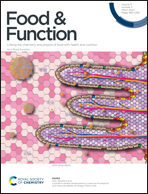Ageing, dehulling and cooking of Bambara groundnuts: consequences for mineral retention and in vitro bioaccessibility†
Abstract
Postharvest storage of legumes is a strategy to ensure food security. However, the hard-to-cook phenomenon, partly explained by pectin–cation–phytate theory, may develop during storage. Based on this theory, minerals could be redistributed within the matrix, affecting the concentration of free/bound minerals and hence their bioaccessibility. Therefore, this study investigated the influence of storage-induced ageing and subsequent dehulling, soaking and cooking treatments on the concentration and in vitro bioaccessibility of Ca, Mg, Fe and Zn in Bambara groundnuts. ICP-OES was performed to determine Ca, Mg, Fe and Zn concentrations after applying different treatments and after simulated digestion in the context of bioaccessibility determination. This study illustrates that while the seed coat is rich in Ca (51%), it contains only less than 15% of Mg, Fe or Zn. Hence, dehulling negatively influenced Ca, but not Mg, Fe or Zn concentration. During soaking, up to 10% or 56% of the initial Mg concentration leaches into whole or dehulled seeds, respectively. Prolonging the cooking time (300 min) of whole aged Bambara groundnuts (32 weeks), necessary for obtaining palatable textures, decreased the overall Mg, Fe and Zn concentrations by 72%, 57% and 48%, respectively. Storage-induced ageing significantly decreased Ca solubility and bioaccessibility. Bioaccessibility of trace minerals in Bambara groundnuts is low, especially for Fe, and cannot be improved by dehulling or cooking treatments. Ageing did not influence Fe and Zn bioaccessibility. Populations relying on both fresh and aged Bambara groundnuts may still be at risk for mineral deficiencies.



 Please wait while we load your content...
Please wait while we load your content...